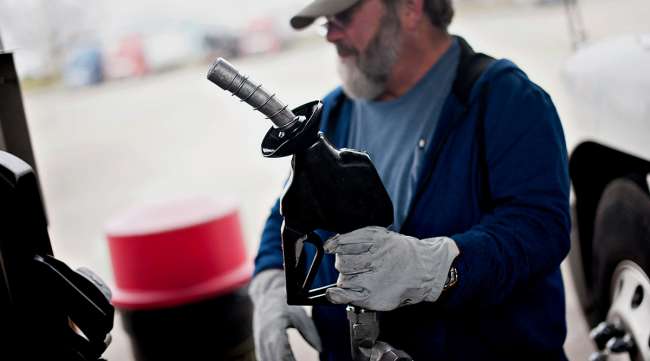Senior Reporter
Diesel Continues Slow, Steady Upward Climb

[Stay on top of transportation news: Get TTNews in your inbox.]
The national average retail price of diesel rose for the fifth consecutive week, up seven-tenths of a cent to $2.437 a gallon, the Energy Information Administration reported July 6.
Even with the increase from $2.43, the price of trucking’s primary fuel is 61.8 cents a gallon less than it was a year ago.
Gasoline took even less of a leap forward with an increase of three-tenths of a cent to settle at $2.177 for the national average, still 56.6 cents lower than a year ago.
The price of diesel increased in nine of the 10 regions of the country surveyed by EIA.

Transport Topics introduces its newest digital interview series, Newsmakers, aimed at helping leaders in trucking and freight transportation navigate turbulent times. Audience members will gain access to the industry's leading expert in their particular field and the thoughtful moderation of a Transport Topics journalist. The inaugural episode — "Understanding Trucking's Economic Landscape" — featuring American Trucking Associations Chief Economist Bob Costello, will air live on July 9 at 2 p.m. ET. Registration is free. Sign up today.
The Central Atlantic region was the only area where prices declined, sliding eight-tenths of a cent to $2.696 a gallon.
The most expensive diesel in the nation remains in California, where the average price rose 1.4 cents to $3.26 a gallon, but that still is 69.3 cents cheaper than at this time in 2019. California had the biggest increase in the nation.
The West Coast had the second-largest increase, as prices jumped 1.2 cents per gallon to $2.96.
The least expensive fuel remains along the Gulf Coast, where the price of diesel increased by a penny to $2.204 a gallon. The Gulf Coast is home to much of the nation’s oil and gasoline production and a large share of the refining capacity. Generally, the lower cost of transporting crude oil and refined products keeps prices substantially lower. In that region, the cost of diesel is 60 cents less expensive than it was a year ago.
RELATED: Oil’s Rally Falters in US With Summer Demand Looking Bleak
Meanwhile, in its new Short-Term Energy Outlook report released July 7, the EIA raised its forecasts for the U.S. and global benchmark oil prices and U.S. crude production for both the remainder of 2020 and 2021.
The EIA said it expects domestic oil production to average 11.63 million barrels per day this year, up 0.6% from its earlier report. It also increased its 2021 forecast by 1.6% to 11.01 million barrels per day.
Check out EIA’s July Short-Term Energy Outlook (#STEO), which provides forecasts through the end of the next calendar year for consumption, supply, trade, and prices across major fuel types. https://t.co/rHp1NDfbcb pic.twitter.com/sFYWj0UTMJ — EIA (@EIAgov) July 7, 2020
“Changes in supply and demand have shifted global oil markets from an estimated 21 million barrels per day of oversupply in April to inventory draws in June,” EIA Administrator Linda Capuano said in a statement. “EIA estimates June consumption increased by almost 10 million barrels per day from April at the same time that global supply fell by 12 million barrels per day as a result of reduced production from OPEC+ and price-driven declines in the United States and Canada.”
Oil industry analyst Tom Kloza, the founder of the Oil Price Information Service, told Transport Topics domestic oil production should increase as oil demand improves when the coronavirus eventually wanes.

Kloza
“This is not the end of shale; rocks don’t die,” he said. “It will come back, probably in 2021 and 2022, when we get a little bit higher prices.”
But while the EIA is forecasting an uptick in domestic production, the weekly Baker-Hughes rig count shows that less oil is being produced in the U.S.
For the week ending July 2, 263 rigs were in operation. That’s two fewer than the previous week and 700 fewer than the same period in 2019.
Another critical factor in future domestic oil production may be the decision by several energy companies and a federal judge concerning two major pipelines.
On July 5, Dominion Energy and Duke Energy canceled the Atlantic Coast Pipeline due to what it called “ongoing delays and increasing cost uncertainty, which threatens the economic viability of the project.” The $8 billion, 600-mile natural gas pipeline was to have run from Harrison County, W.Va., to Robeson County, N.C.
“This announcement reflects the increasing legal uncertainty that overhangs large-scale energy and industrial infrastructure development in the United States. Until these issues are resolved, the ability to satisfy the country’s energy needs will be significantly challenged,” Dominion Energy Chairman Thomas Farrell and Duke Energy CEO said Lynn Good in a joint statement.

Members of the Standing Rock Sioux Tribe and their supporters march toward the White House on March 10, 2017. Years of protests paid off this week for the tribe when a federal judge ordered the shutdown of the Dakota Access Pipeline. (Manuel Balce Ceneta/Associated Press)
In another pipeline-related matter, federal judge James Boasberg ordered the Dakota Access Pipeline to shut down for additional environmental review more than three years after it began pumping oil, handing a victory to the Standing Rock Sioux Tribe in South Dakota.
In his order, the judge said he was “mindful of the disruption” that shutting down the pipeline would cause, but it must be done within 30 days. The pipeline owner, Energy Transfer Partners of Dallas, says it plans to ask a court to halt the order and will seek an expedited appeal.
Oil industry analyst Phil Flynn told Transport Topics he’s worried shutting down the pipelines could reduce domestic energy production in the long run.
“By shutting down these pipelines, you’re also going to hurt further the U.S. shale industry, which is already struggling because of COVID-19,” he said. “It’s going to also reduce our energy security because we’ll be more reliant on foreign actors for our energy. It’s also going to lead to the loss of more jobs and more bankruptcies in the shale industry.”
Want more news? Listen to today's daily briefing:
Subscribe: Apple Podcasts | Spotify | Amazon Alexa | Google Assistant | More




